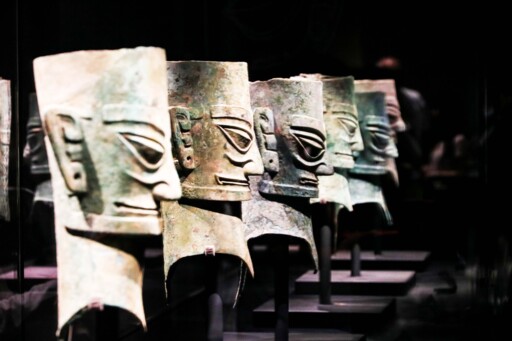


From regional roots to national legacy: Upper Yangtze in Chinese civilization

Bronze statues from the Sanxingdui site in Sichuan Province Photo: IC PHOTO
From the perspective of regional civilization and cultural geography, the Yangtze River Basin can generally be divided into three sections: the upper, middle, and lower reaches. The upper reaches, with the Sichuan Basin at the center, include present-day Chengdu, Chongqing, northern Yunnan, and eastern Guizhou.
Close and inseparable ties with the Central Plains
In the pre-Qin era, more than 5,000 years ago, the Baodun Culture emerged in the Chengdu Plain at the dawn of civilization in the upper Yangtze. Entering the Bronze Age, the region transitioned from the Neolithic period with the appearance of the Sanxingdui Culture, the Jinsha Culture, and the so-called “Boat-Coffin Burial Culture” [in the pre-Qin period, what is now Sichuan Province and Chongqing Municipality in southwest China saw the emergence of numerous boat-shaped coffin burials, a funerary practice not found elsewhere at the time]. These cultural phases spanned from the Erlitou period (approximately 21st to 17th centuries BCE) through the Spring and Autumn (770–476 BCE) and Warring States periods (475–221 BCE). Although some gaps remain, the overall trajectory of cultural development here was independent and continuous.
The civilization of the upper Yangtze maintained close ties with the Central Plains. Taking the assemblages unearthed from Sanxingdui and Jinsha as examples, while many artifacts bear strong local characteristics, bronze zun and lei vessels closely resemble their Central Plains counterparts in both form and decoration. Certain motifs and patterns, while inspired by Central Plains bronze vessels, are also similar to bronzes from the middle Yangtze, such as those from Hubei and Hunan provinces. This suggests that Sanxingdui maintained exchanges with the bronze civilizations of both the Yellow and Yangtze River systems, and that its bronze craftsmanship may even have been directly influenced by the middle Yangtze. The jades unearthed from Sanxingdui and Jinsha—such as ceremonial blades (yazhang) and bi discs—belong to the same system as prehistoric jade artifacts from the Yellow and Yangtze River basins. The bronze zun vessels from the Sanxingdui sacrificial pits were all made using the same “clay section-mold casting” technique employed in the Central Plains.
Becoming an important part of Chinese civilization
The southwestern region of China, including the upper Yangtze, had long been home to multiple ethnic groups. It was only after the Qin (221–207 BCE) and Han (206 BCE–220 CE) that it gradually merged into the Central Plains cultural sphere. In 316 BCE, after Qin State conquered the Sichuan Basin, it used the region as a strategic base to move down the Yangtze, defeat the powerful state of Chu, and sweep across the remaining powers, completing national unification.
During the reign of Emperor Wu of Han (r. 141–87 BCE), several large-scale development campaigns were carried out in southwest China. The government implemented the centralized commandery–county system [under which all officials were appointed and removed by the central court, ensuring direct imperial control over local administration], and local governments in Yizhou [in present-day Sichuan Province, with its administrative center in Chengdu] established official schools to promote Han cultural education. At the same time, the central government adopted a flexible “dual-track system,” continuing to enfeoff local tribal leaders in the southwest, granting seals such as the “Seal of the King of Dian,” thereby exercising effective central control. In recent years, discoveries at the Hebosuo site in Jinning, Yunnan—location of the Yizhou Commandery administrative center during the Han and Jin era (266–420) and the King of Dian’s tomb—have yielded numerous seals, seal impressions, and wooden slips, vividly illustrating the Han government’s political, economic, and cultural policies on the southwestern frontier. During the Qin and Han periods, southwest China gradually integrated and ultimately became part of the unified, multi-ethnic system of the Qin and Han dynasties.
Since ancient times, the upper Yangtze has also served as a key hub for cultural exchange between China and the outside world, playing a special role in enabling Chinese civilization to absorb foreign cultural elements. Geographically, it connects eastward to the middle and lower Yangtze, southward to India and Southeast Asia, northward to the Qinba Mountains, and westward to the Qinghai–Xizang Plateau. Archaeological evidence shows that as early as about 150,000 years ago, the Piluo site on the eastern edge of the plateau broke the so-called “Movius Line” [an imaginary boundary used to explain a major difference in Paleolithic stone tool technology between the western and eastern parts of the Old World] by yielding a set of handaxes [confirming the existence of a complete Acheulean technological tradition in East Asia], offering new evidence for human migration routes along the plateau’s eastern edge and fresh clues to Paleolithic technological interaction between East and West.
Huo Wei is a professor from the School of History and Culture at Sichuan University.
Copyright©2023 CSSN All Rights Reserved